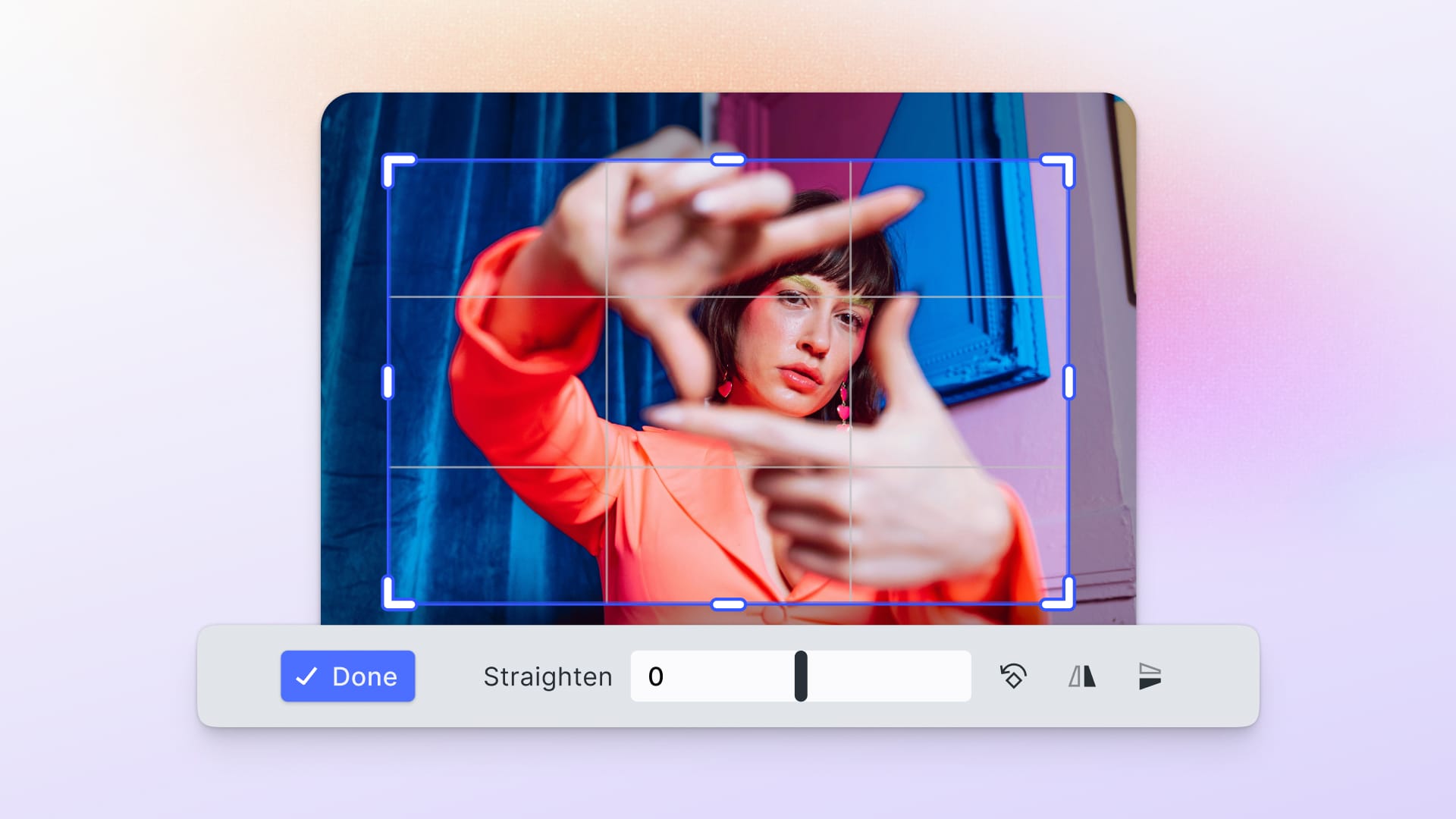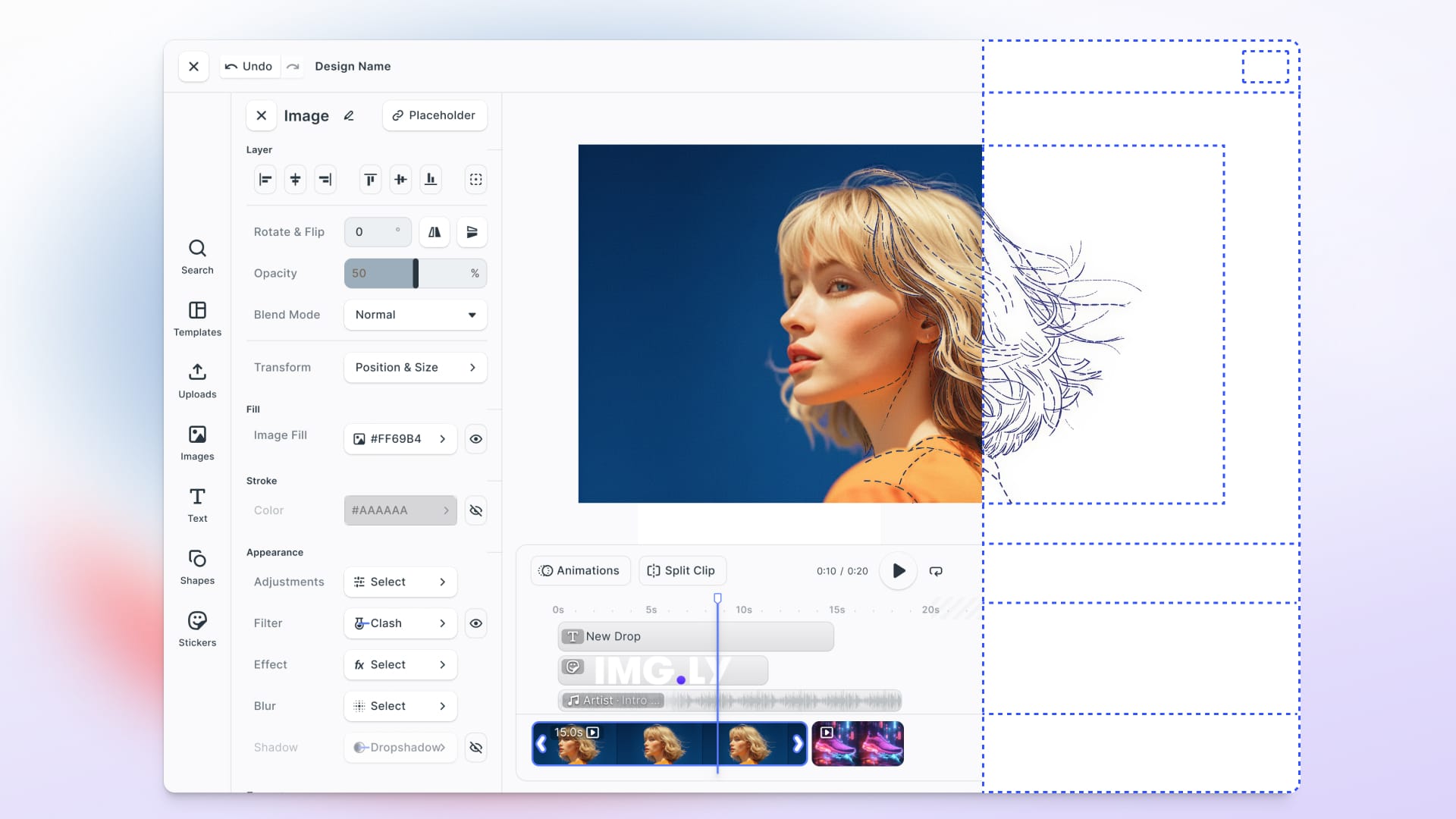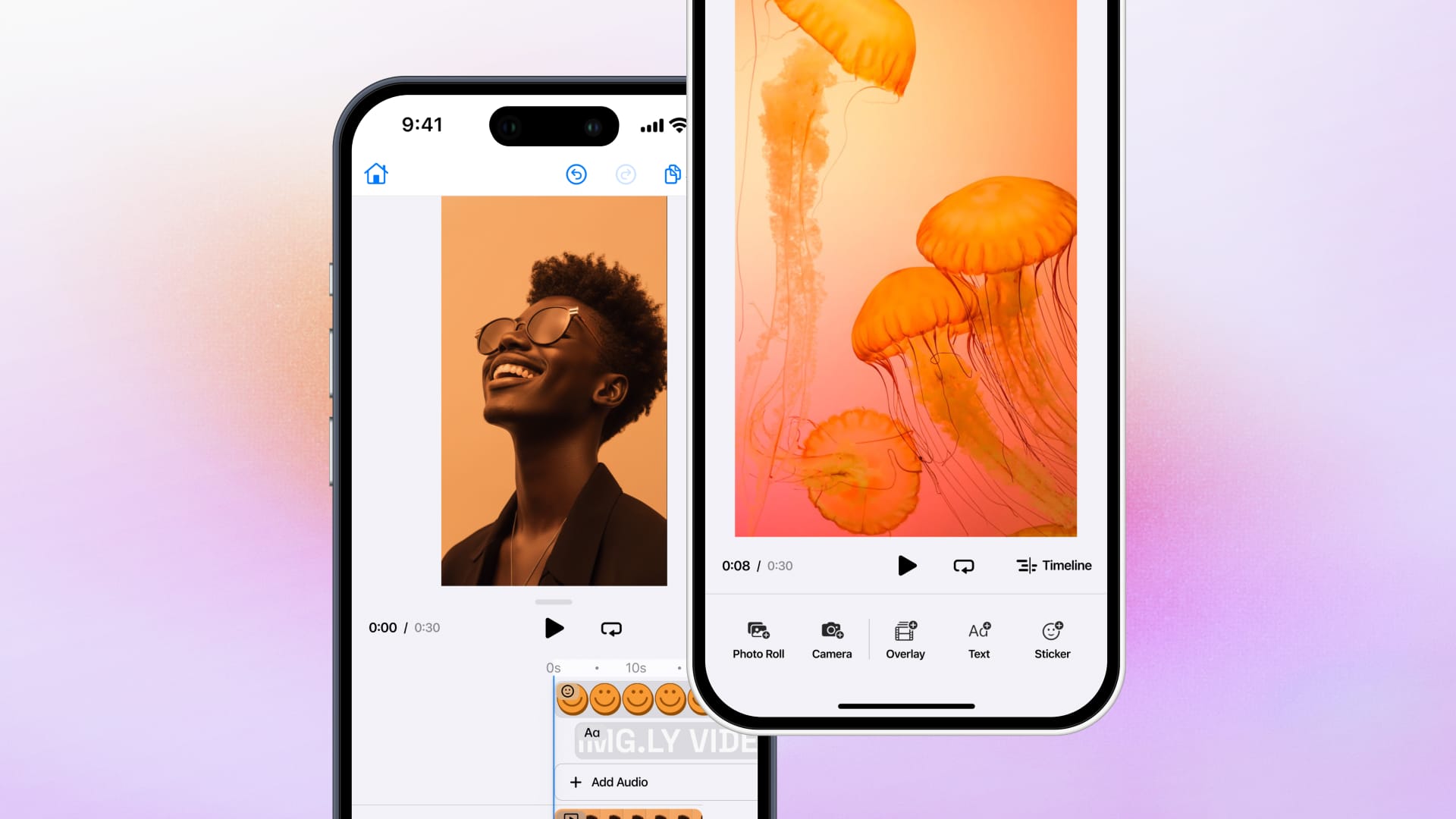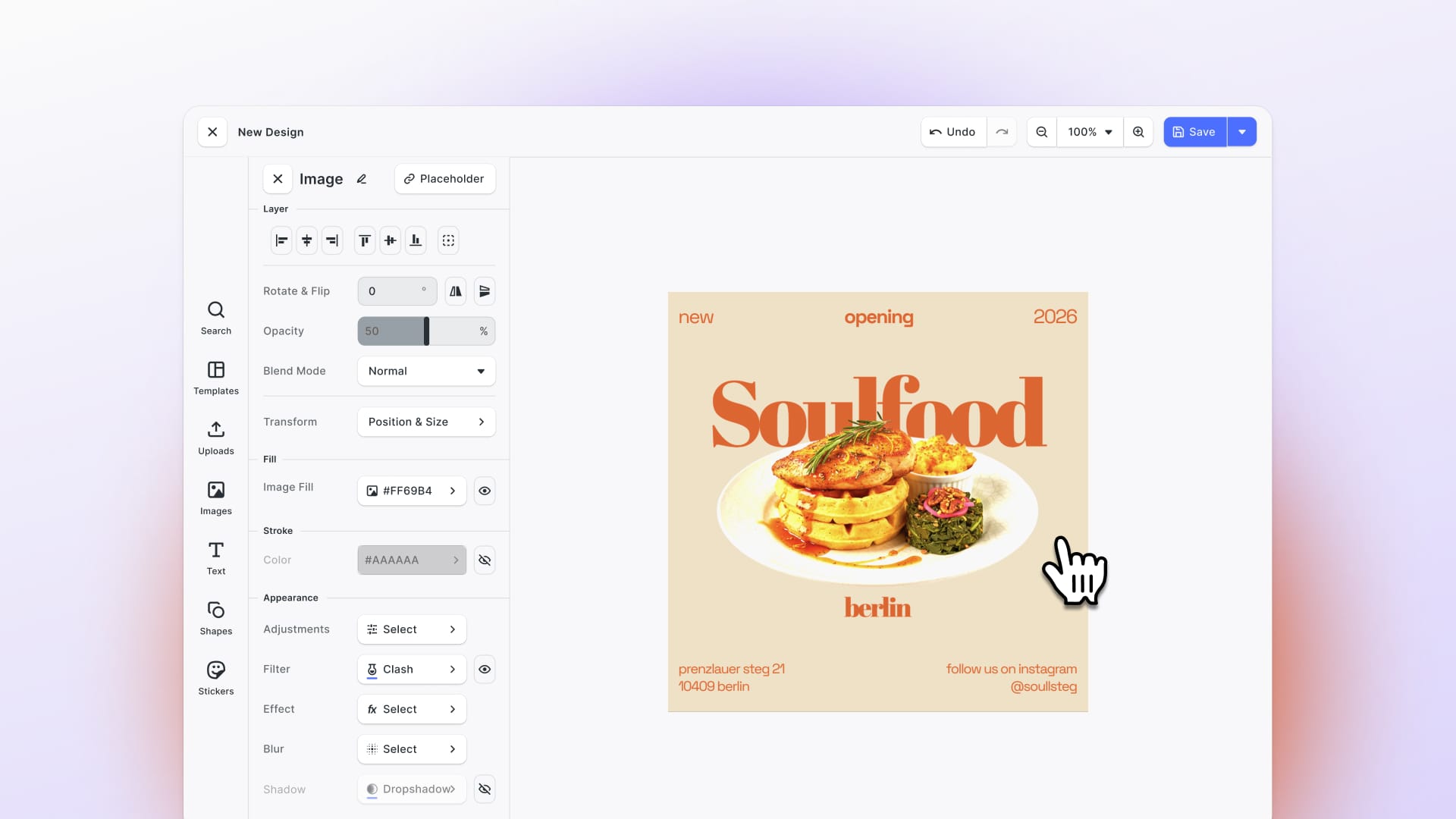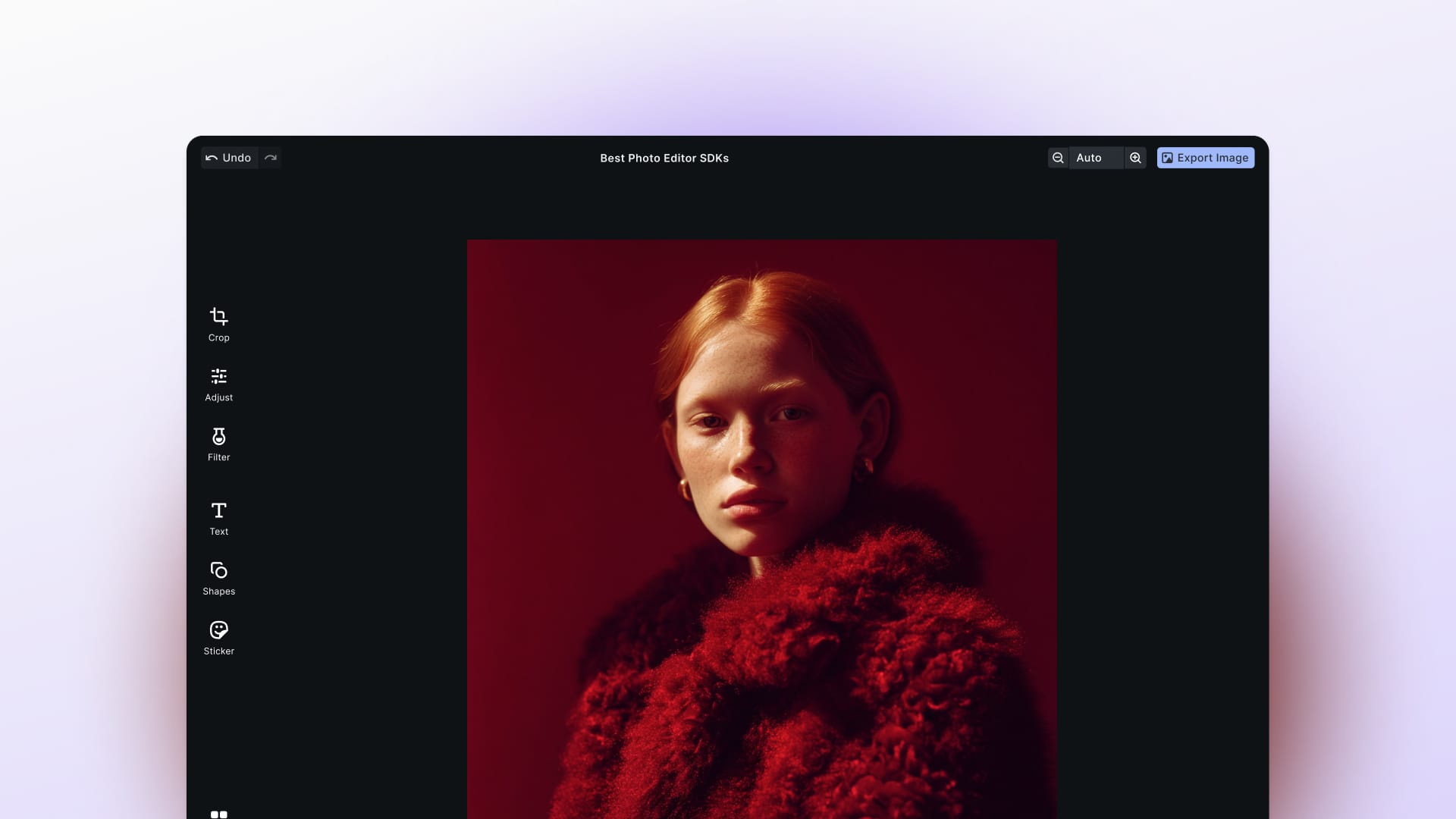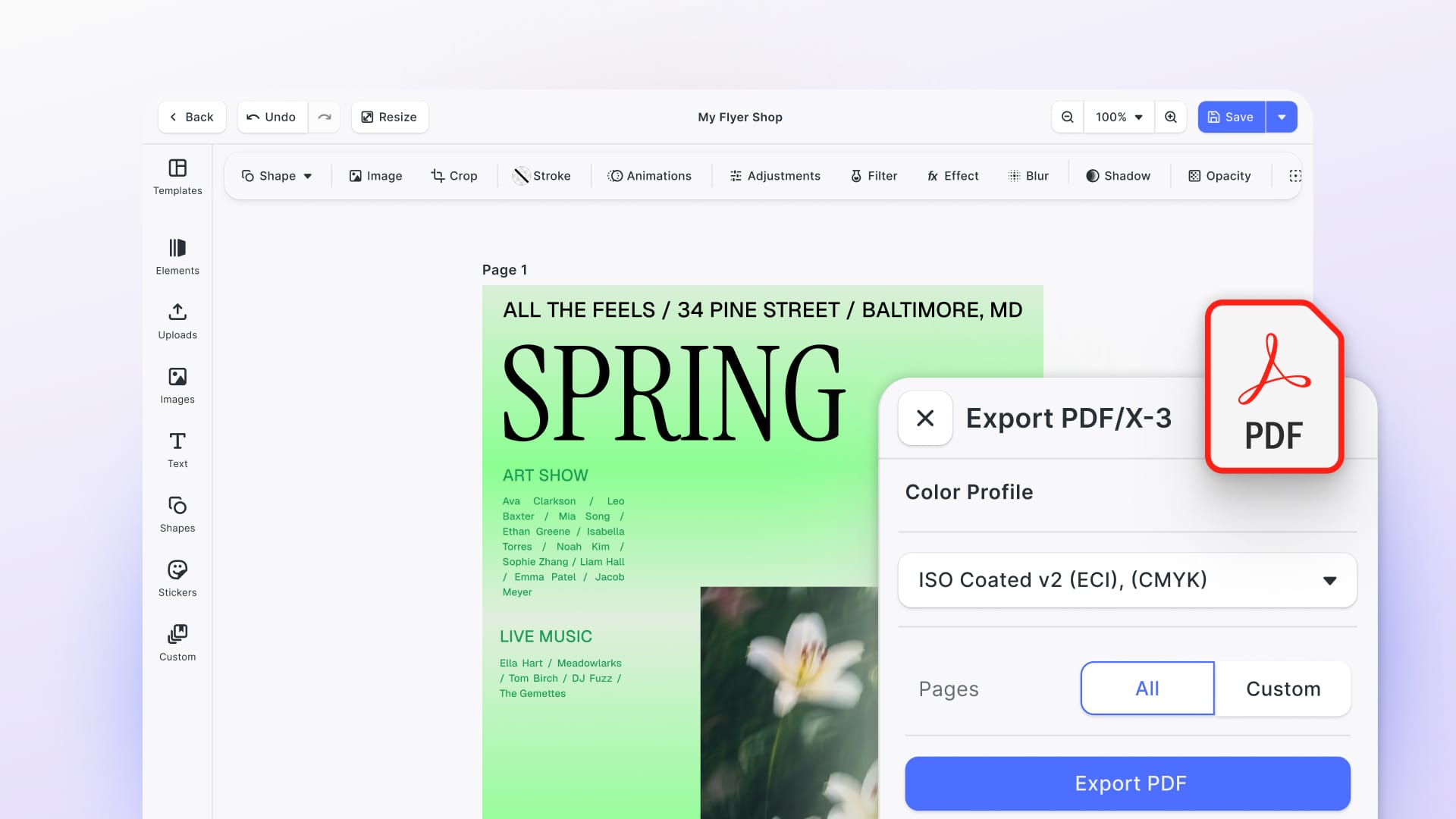In this guide, we’ll compare seven leading image editor SDKs - IMG.LY (CreativeEditor SDK), Fotor, Banuba, Pintura, Polotno, Imgpen, and Cloudinary, by focusing on each of their:
- Features & capabilities
- Implementation & use cases
- Future-Proofing, support & pricing
At the end, we’ll give honest feedback on who would benefit the most from using these different tools and highlight where IMG.LY CreativeEditor SDK stands out as the most complete, enterprise-ready option.
1. IMG.LY CreativeEditor SDK (CE.SDK)
IMG.LY CreativeEditor SDK is an enterprise‑grade design and editing SDK that supports photo, video, and template workflows. It goes beyond simple photo adjustments to deliver a scalable editing tool that fits easily into products used by millions of end‑users.
- Features & capabilities: CreativeEditor SDK offers a full suite of photo editing tools including filters, adjustments, cropping, and background removal, alongside advanced design capabilities. You can layer elements, apply templates, and use generative features to streamline creative workflows. CE.SDK offers complete content creation and personalization experiences.
- Platforms & customization: Available for Web, iOS, Android, React Native, Flutter, Node.js, and Electron. The SDK is white-label and fully customizable. You control the entire UI and can extend functionality with plugins, making it suitable for teams that want both flexibility and enterprise stability.
- Implementation & use cases: Integration is straightforward with ready-made UIs for image editing. Businesses use CE.SDK to power e-commerce personalization, marketing platforms, DAMs, SaaS tools, and social apps. A key differentiator of CE.SDK is a single engine that runs across platforms, ensuring consistent performance and reducing development overhead.
- Future-Proofing, support & pricing: IMG.LY follows a clear AI-driven roadmap, with frequent feature releases and updates. Customers benefit from SLAs, dedicated onboarding, and solution engineers. Pricing is based on custom enterprise licensing, ensuring it aligns with your business needs.
- Who its for: CE.SDK is perfect for companies looking for more than a basic photo editor. If you want a scalable solution that supports automation, cross-platform deployment, and advanced design features, CE.SDK is the strongest choice.
Key differentiator
CE.SDK is the only SDK that combines a polished, embeddable editor with a scalable automation engine in a single stack. This means you don’t need separate tools for editing and backend workflows. This integration saves development time, reduces costs, and ensures a smoother experience for end users. For teams building long-term products, this combination is a significant competitive advantage.
See the CreativeEditor SDK showcase for examples of its photo editing UI in action.
2. Fotor SDK
Fotor SDK is an AI-first editing API/SDK with a focus on automation. It provides ready-to-use AI endpoints that help teams handle common tasks like background removal and retouching without building their own machine learning models.
- Features & capabilities: Fotor SDK focuses on AI-driven editing. It offers background removal, AI upscaling, skin retouching, magic eraser, and face unblur. The tools are strong for quick, one-off edits but limited in scope, mainly targeting simple editing tasks rather than broader workflows.
- Platforms & customization: Primarily web-based with some mobile support through APIs. Customization is minimal compared to other UI SDKs since Fotor is focused on prebuilt AI endpoints.
- Implementation & use cases: Setup is fast, but teams need to build their own UI for more complex workflows. Common use cases include e-commerce product photo cleanups and social integrations.
- Future-proofing, support & pricing: Fotor invests heavily in AI features but is smaller in scale compared to enterprise-ready vendors. Commercial support is available, and pricing follows a tiered SaaS model.
- Who it’s for: Fotor SDK is suitable for teams wanting fast AI editing without building in-house ML.
How it compares to IMG.LY
Fotor is best for narrow AI workflows, making it useful when you only need quick automation. IMG.LY, on the other hand, supports both automated editing and rich, customizable UIs in a single platform. This gives product teams the flexibility to deliver fast AI-powered edits while also providing a full-featured editor that can scale to enterprise needs. For businesses building long-term creative workflows, this combination ensures they don’t outgrow the tool as their product evolves.
3. Banuba Photo Editor SDK
Banuba Photo Editor SDK is a mobile‑first solution specialized in AR and beauty editing. It is widely used in apps where engaging face filters and real‑time effects are critical to user experience.
- Features & capabilities: Banuba is designed for AR and beauty editing. It offers features like virtual makeup, skin smoothing, AR masks, and background replacement. This makes it particularly popular for apps where face editing and engagement features are key.
- Platforms & customization: Banuba supports iOS, Android, React Native, and Flutter. Its modular SDK allows developers to mix and match features, but its focus is mobile-first.
- Implementation & use cases: Banuba’s integration is fast for mobile apps, especially those in social media, UGC apps, beauty, and fashion e-commerce. However, support for web-based apps is quite limited.
- Future-proofing, support & pricing: They are expanding their AR and AI stack, adding new features in line with industry trends. They offer enterprise agreements for larger customers, but pricing is high and not public, which can make it difficult for smaller teams to evaluate or plan budgets.
- Who it’s for: Banuba is suitable for social media apps, beauty brands, and fashion retailers where AR features are essential to the product.
How it compares to IMG.LY
Banuba dominates in AR and beauty features, making it a strong choice for social or fashion apps. IMG.LY, however, is designed for enterprise use cases where scalability, cross‑platform consistency, and deeper workflow integration matter most. While Banuba is powerful for AR effects, IMG.LY combines editing, automation, and enterprise‑grade support, helping teams build creative products that can grow and adapt across both mobile and web platforms.
Learn more about how IMG.LY compares to Banuba here.
4. Pintura
Pintura is a JavaScript image editor SDK built specifically for the browser. It’s designed to be lightweight and developer-friendly, making it a good fit for teams that need straightforward image editing without enterprise-level complexity.
- Features & capabilities: Pintura covers essential editing tasks such as cropping, rotating, resizing, and applying filters. It provides a clean editing interface that feels polished despite its narrower scope.
- Platforms & customization: Works in the browser and supports vanilla JS, React, Vue and Angular. Developers can integrate it easily and customize the UI to fit their application’s look and feel.
- Implementation & use cases: Setup is simple and quick, which makes it appealing for SaaS products and web apps that want to add photo editing features without heavy development. It’s commonly used for lightweight content creation and adjustments inside web platforms.
- Future-proofing, support & pricing: Pintura is actively maintained, but its scope is intentionally limited. Support options are modest, reflecting the vendor’s smaller scale. Pricing is offered as a one-time license or annual subscription, which may suit smaller teams with predictable budgets.
- Who it’s for: Developers who want a reliable, browser-native editor for web apps and don’t need advanced enterprise workflows.
How it compares to IMG.LY
Pintura is ideal for lightweight browser-native projects where simplicity matters most. IMG.LY, however, delivers an enterprise-grade SDK with broader capabilities, including automation, multi-platform support, and advanced customization. For teams that expect their product to scale or require editing as part of larger workflows, IMG.LY provides the flexibility and stability that Pintura doesn’t provide yet.
Find out more about how IMG.LY is a great alternative to Pintura here.
5. Polotno
Polotno is a JavaScript framework built for developers who want to create custom design and photo editors from the ground up. It offers a flexible canvas environment but shifts most of the responsibility for UI and workflow design onto the development team.
- Features & capabilities: Supports canvas editing, text, shapes, and stock image integrations. Because it’s more of a toolkit than a finished editor, teams can tailor it in almost any direction, but they also need to do more work to reach a polished product.
- Platforms & customization: Polotno runs on the web with JavaScript. It’s highly flexible, but developers must build their own UI and workflow, which increases development effort compared to ready-made SDKs.
- Implementation & use cases: Polotno is best suited for prototyping, SaaS experiments, or internal tools where flexibility is more important than speed because creating a production-ready editor requires significant investment in development time.
- Future-proofing, support & pricing: The tool is community-driven, which means it benefits from active developers but lacks the proven enterprise readiness of larger vendors. Support is limited to community forums, and pricing is through a commercial licence.
- Who it’s for: Polento is best for developers who want full control and are willing to build editors from scratch rather than use a prebuilt solution.
How it compares to IMG.LY
Polotno gives you a foundation to build a custom editor, but leaves scalability, long-term support, and advanced workflows to your team. IMG.LY, on the other hand, delivers enterprise-grade stability, a rich feature set, and an AI-powered roadmap right out of the box.
For businesses that want to move quickly, reduce technical overhead, and rely on a proven partner, IMG.LY is the better choice.
Read our detailed guide on IMG.LY vs. Polotno to know more.
6. Imgpen
Imgpen is a lightweight, web-focused photo editing SDK built for simple integrations. It is aimed at small teams that need quick editing features without enterprise complexity.
- Features & capabilities: Imgpen provides only basic image editing features like filters, cropping, text overlays, and simple effects. These features are useful for apps that want to give users quick editing options without overwhelming them, but they lack the depth required for more advanced creative workflows.
- Platforms & customization: Imgpen runs on the web with JavaScript and offers minimal customization options. Teams can adjust the look and feel slightly, but the SDK doesn’t allow for deeper UI or workflow changes, which can limit how well it fits into complex applications.
- Implementation & use cases: The SDK is easy to set up and lightweight, making it attractive for small SaaS apps, niche tools, or websites that need basic editing capabilities. It’s best suited for scenarios like adding a quick photo filter in a social widget or allowing simple image adjustments in a lightweight web app.
- Future-proofing, support & pricing: The vendor’s roadmap is unclear, and the small team behind Imgpen means resources for updates or long-term support are limited. But their pricing is affordable, which makes it appealing for startups or teams on a budget.
- Who it’s for: Teams with lightweight editing needs, small budgets, or projects where image editing is a side feature rather than a core part of the product.
How it compares to IMG.LY
Imgpen is budget‑friendly and covers the basics of photo editing, which may be useful for lightweight apps or early-stage projects.
However, if you’re looking for full‑scale deployments with advanced editing, automation, and enterprise‑grade support, IMGLY is the better option. For teams that want their product to evolve and scale, IMG.LY ensures they don’t hit limitations as their needs grow.
7. Cloudinary SDK
The last on the list is Cloudinary, which is best known as a media management and optimization platform that also provides an SDK for image editing. It focuses on performance and delivery, helping companies manage and serve large volumes of media efficiently.
- Features & capabilities: For editing photos, Cloudinary offers features like cropping, resizing, optimization, filters, effects, and format conversion.
- Platforms & customization: Cloudinary supports web, iOS, and Android. It is built around APIs, which give developers strong control over how media is processed and delivered. However, it does not include a ready-made editor interface for end users.
- Implementation & use cases: Cloudinary is simple to integrate into media-heavy platforms that need to serve thousands of images quickly. It is often used by e-commerce sites, publishing platforms, and other services where fast delivery and optimized file sizes are essential.
- Future-proofing, support & pricing: Cloudinary is a mature, established vendor with enterprise-grade support available globally. Pricing is usage-based, so your costs scale with the volume of media processed and delivered.
- Who it’s for: Companies that want to focus on managing, delivering, and optimizing large media libraries rather than offering in-app image editing features.
How it compares to IMG.LY
Cloudinary excels in infrastructure and is a strong choice for optimizing and delivering media at scale.
However, it doesn’t provide an in‑app editing experience. IMG.LY combines those infrastructure capabilities with advanced editing and automation, giving teams both performance optimization and the creative tools their users expect. This makes IMG.LY a stronger option for teams building creative products that want to offer a complete creative workflow, not just media delivery.
Overview Table
| Use Case / Solution | IMG.LY | Fotor | Banuba | Pintura | Polotno | Imgpen | Cloudinary |
|---|---|---|---|---|---|---|---|
| Marketing tech | ✅ Empowers marketing platforms with templates, AI tools, and scalable automation built directly into the editor. | ⚠️ Useful for quick AI edits like background removal or face retouching but lacks workflow depth. | ⚠️ Strong for AR-driven campaigns but limited outside mobile and UGC contexts. | ⚠️ Lightweight embeddable editor that works well for simple marketing visuals but lacks automation features. | ⚠️ Provides a toolkit for building custom editors, but requires heavy dev lift to tailor for marketing campaigns. | ⚠️ Covers the basics (filters, cropping, text), suitable for simple marketing visuals but not enterprise-scale. | ✅ Strong at automating media pipelines and transformations, but does not provide a polished marketing editor UI. |
| E-commerce | ✅ Powers product personalization with ready-made templates, AR extensibility, and fast scaling across platforms. | ✅ Delivers fast product photo enhancements with AI tools like upscaling and background replacement. | ✅ Excels in AR try-on for fashion, beauty, and product experiences, enabling immersive commerce. | ⚠️ Suitable for basic adjustments (crop, resize) but not optimized for e-commerce personalization. | ⚠️ Can be customized for commerce, but requires substantial developer investment to create workflows. | ⚠️ Simple tool for product image touch-ups; not built for scaling catalogs. | ✅ Optimizes product visuals at scale through automated resizing, cropping, and delivery workflows. |
| Social media | ✅ Offers a polished, social-ready editor enhanced with AI plugins and template-driven workflows. | ✅ Adds value with quick AI-driven enhancements and creative filters for social visuals. | ✅ Specializes in AR masks, beautification, and TikTok-like effects to boost engagement. | ⚠️ Lightweight browser editor suitable for quick edits but lacks advanced social features. | ⚠️ Developers can build a social editing tool from scratch, but it’s not turnkey. | ⚠️ Provides only essential photo edits, limiting its value for social-first apps. | ⚠️ Optimizes delivery of social media assets but does not enable editing UX. |
| Enterprise SaaS | ✅ Provides a full enterprise-ready stack with SLAs, SSO, theming, and scalable deployment options. | ⚠️ Offers enterprise support but is less suited for general enterprise SaaS workflows. | ❌ Aimed at mobile apps and SMBs, less suited for enterprise SaaS workflows. | ⚠️ Affordable and stable for small SaaS apps, but not designed for large-scale enterprise. | ⚠️ Offers flexibility, but enterprise readiness and SLAs are limited. | ❌ Too lightweight for serious enterprise use cases. | ✅ A proven, enterprise-grade platform for media management and transformations at scale. |
| Native mobile experience | ✅ Provides SDKs for iOS, Android, React Native, and Flutter with deep cross-platform support. | ⚠️ Web-first, with mobile support mainly via API integrations. | ✅ Mobile-first with advanced AR and beauty tools optimized for iOS and Android. | ❌ Browser-based only; no native mobile SDK support. | ❌ Runs only in the browser; lacks native SDK support. | ❌ Web-only solution, not optimized for mobile-native apps. | ✅ Mobile SDKs available for iOS and Android, focused on transformations and optimization rather than full editing UX. |
Conclusion
Each SDK that we’ve listed here is unique and offers different features. The right choice between these tools depends on your product goals and customer expectations. Here’s a quick rundown:
- Banuba: Best for AR and beauty use cases, particularly in social and fashion apps.
- Fotor: Great for AI-powered quick edits where automation is the main priority.
- Pintura, Polotno, Imgpen: Lightweight, developer-focused solutions that work for smaller projects or teams with specific, limited needs.
- Cloudinary: Strong for media optimization and delivery when speed and performance are top concerns.
IMG.LY CreativeEditor SDK: The only SDK that unites polished editing UX with automation, cross-platform support, and enterprise stability. Read on to know more.
Why IMG.LY stands out?
Taken together, these comparisons show a clear pattern: most SDKs solve a narrow problem well, but few address the full range of editing, automation, and scalability requirements.
IMG.LY CreativeEditor SDK is built to do exactly that. It allows businesses to offer advanced photo editing directly in their apps, while also supporting automation and backend workflows on a single engine. This dual focus means your team doesn’t need to stitch together multiple solutions to achieve both creative flexibility and operational efficiency.
For product teams, this translates into faster time to market, less technical overhead, and the confidence that the editor will scale as user expectations grow.
If your goal is to build long-term, scalable creative tools, IMG.LY CreativeEditor SDK offers the most complete package and ensures your product can evolve without hitting limits. To learn more about how CreativeEditor SDK can support your business, get in touch with our team at IMG.LY, and we’ll be happy to guide you!
